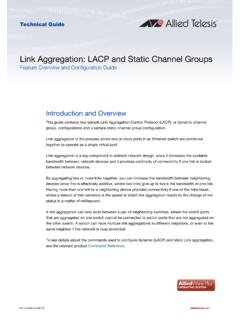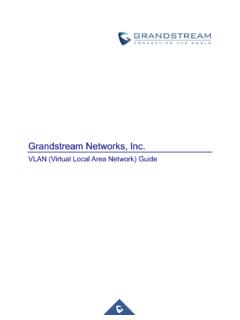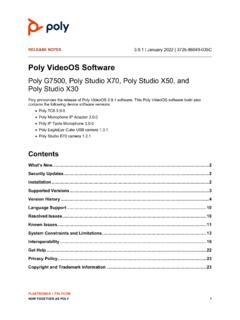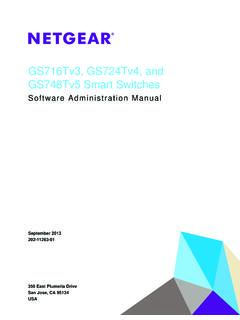Transcription of Virtual LANs (VLANs) - Allied Telesis
1 REV CTechnical GuideTechnical GuideTechnical GuideTechnical GuideTechnical GuideFeature Overview and Configuration GuideVLAN IntroductionThis guide describes Virtual LANs (VLANs), VLAN features and configuration on the begins with a description of what a VLAN is, its evolution and purpose, and also provides the meaning of some common VLAN is followed with a detailed look at VLAN implementation. Port-based VLAN membership is the most common way to split a network into sets of Virtual LANs. We look at how this is achieved using the VLAN use of double-tagging (or VLAN stacking) to tunnel VLANs across Layer 2 networks is described, and an example is provided for the configuration of VLAN we discuss private VLANs and the communication rules that limit what is possible between devices operating within the VLAN.
2 AlliedWare Plus has two private VLAN solutions: private VLANs for ports in Access Mode private VLANs for ports in Trunked ModeConfiguration examples are provided for both of these , we look at combining private VLANs with other features, such as: EPSR, ARP, lldp , GVRP, Link aggregation, and management servers. The guide ends with a section on configuring protocol based VLANs and then describes how data counters are used to count both the number of received frames or the number of received bytes (octets) belonging to a particular LANs (VLANs)Page 2 | Products and software version that apply to this guideProducts and software version that apply to this guideThis guide applies to all AlliedWare Plus products, running version or later.
3 However, not all features in this guide are supported on all products. To see whether a product supports a particular feature or command, see the following documents: The AlliedWare Plus Datasheet The product s Datasheet The product s Command ReferenceThese documents are available from the above links on our website at Feature support may change in later versions. For the latest information, see the above Introduction ..1 Products and software version that apply to this guide .. 2 Virtual 4 What is a VLAN? .. 4 The purpose of 4 Using routers to segment 5 Using switches to segment 5 Domain 6 Using VLANs to segment LANs.
4 6 Implementing 8 Port-based VLANs .. 8 Distributing a single VLAN across multiple 8 How does tagging work?.. 9 Mixing tagged and untagged packets on the same 10 Only accepting packets that match the port s VLAN configuration (ingress filtering) 11 configuring VLANs .. 12 VLAN Double Tagging (VLAN Stacking) .. 14 How double-tagged VLANs work .. 14 VLAN rules for double 16 configuring double-tagged 16 Private VLANs ..19 AlliedWare Plus private VLAN solutions .. 20 Private VLANs for Ports in Access 20 Products and software version that apply to this guide | Page 3 Membership rules for private VLANs in access mode.
5 21 Promiscuous ports ..21 Host ports ..22 Private VLAN operation with ports in access mode ..23 Access mode private VLAN configuration examples ..25 Private VLANs for trunked port private VLAN configuration tagged and untagged private VLANs Private VLANs with Other Features - Limitations ..33 Using private VLANs with private VLANs with ARP ..33 Using private VLANs with lldp ..34 Using private VLANs with GVRP ..34 Using private VLANs with link aggregation ..34 Using private VLANs with management utility based VLAN configuration example ..36 VLAN Statistics ..38 Counter 4 | What is a VLAN?
6 Virtual LANsA VLAN is a logical, software-defined subnetwork. It allows similar devices on the network to be grouped together into one broadcast domain, irrespective of their physical position in the network. Multiple VLANs can be used to group workstations, servers, and other network equipment connected to the switch, according to similar data and security is a VLAN?In simple terms, a VLAN is a set of workstations within a LAN that can communicate with each other as though they were on a single, isolated LAN. What does it mean to say that they communicate with each other as though they were on a single, isolated LAN ?
7 Among other things, it means that: broadcast packets sent by one of the workstations will reach all the others in the VLAN. broadcasts sent by one of the workstations in the VLAN will not reach any workstations that are not in the VLAN. broadcasts sent by workstations that are not in the VLAN will never reach workstations that are in the VLAN. the workstations can all communicate with each other without needing to go through a gateway. For example, IP connections would be established by ARPing for the destination. IP and sending packets directly to the destination workstation there would be no need to send packets to the IP gateway to be forwarded on.
8 The workstations can communicate with each other using non-routable purpose of VLANsThe basic reason for splitting a network into VLANs is to reduce congestion on a large LAN. To understand this problem, we need to look briefly at how LANs have developed over the years. Initially LANs were very flat all the workstations were connected to a single piece of coaxial cable, or to sets of chained hubs. In a flat LAN, every packet that any device puts onto the wire gets sent to every other device on the the number of workstations on the typical LAN grew, they started to become hopelessly congested; there were just too many collisions, because most of the time when a workstation tried to send a packet, it would find that the wire was already occupied by a packet sent by some other device.
9 Using routers to segment LANs | Page 5 This next section describes the three solutions for this congestion that were developed: Using routers to segment LANs on page 5 Using switches to segment LANs on page 5 Using VLANs to segment LANs on page 6 Using routers to segment LANsThe early solution to this problem was to segment the network using routers. This would split the network into a number of smaller LANs. There would be less workstations on each LAN, and so less congestion. Of course, routable data being sent between LANs would have to be routed, so the layer 3 addresses would have to be organized so that each LAN had an identifiable set of addresses that could be routed to such as an IP subnet or an AppleTalk zone.
10 Non-routable protocols would have to be bridged, which is not quite so congestion-reducing, because bridges forward all broadcasts. But, at least for unicast packets, a bridge only forwards packets if it knows that the destination address is not in the originating switches to segment LANsAs switches became more available, there was a move from chained hubs to a set of hubs connected to a switch. A switch only sends traffic to a given port if the traffic has to go to that port. So switches have the effect of reducing congestion at workstations, by stopping the workstations from seeing all the traffic from the other ports of the simple switched network, though, still needs routers to set the boundaries of where broadcasts are sent (referred to as broadcast containment ).


















